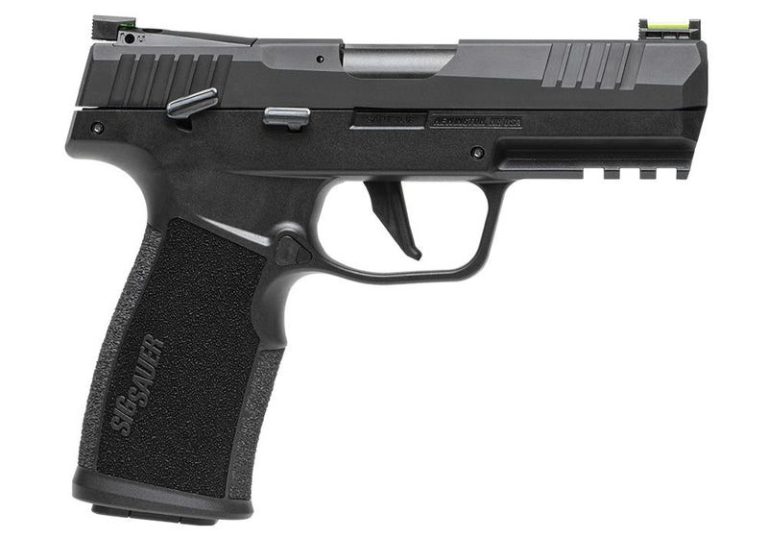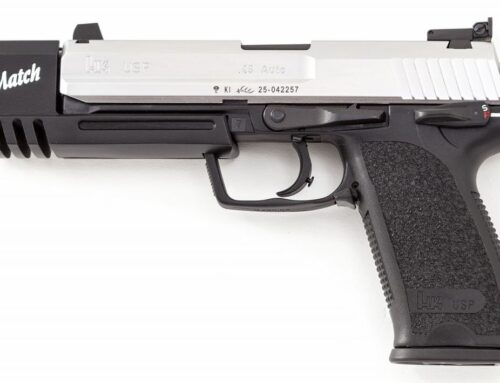Every now and then a firearm comes to market which fires up my interest. I like new, interesting, quirky, or anything which looks like it could be a lot of fun, and .22 pistols by their nature are quite entertaining. When I first heard Sig was coming out with their own take on a ground up built .22 pistol which held twenty rounds in a flush fit mag, interest was immediately present. Does this new offering deliver the goods?
If you’ve handled any Sig handgun in the last ten-odd years then you’d be forgiven for not knowing what you were holding at first. It checks all of the boxes in what you’d expect the ergonomics and texturing to be like as kind of the “middle child” between the P320 and P365 series. This is to say, it has a P320-ish full size grip height but it’s a bit more slim, a little closer to a P365XL. It was comfortable and mated to my palm so well I didn’t give it any thought, it simply felt like it belonged there.
One of Sig’s quirks on more recent firearms is a triangular shaped magazine release. Getting a bit nerdy here, in all other models I can think of this is an equilateral triangle with every corner being the same angle. On the P322 it’s more of an isosceles triangle, like the top and bottom had been pinched slightly. The forward facing point on this one was slightly sharper than I was expecting. Otherwise, it’s just a mag release. Thus ends the Geometry session.
Both the slide catch and safety are ambidextrous and I have to imagine the mag release can be swapped but it’s not natively ambi. The gun itself looks like all of Sig’s striker-fired handguns but the P322 hides an internal hammer. As could be expected this makes the trigger something of an unknown quantity and something which will be given close scrutiny by most rimfire enthusiasts.
If you’re a target shooter looking for a nicely tuned Volquartsen trigger which goes off if your heart beats too hard, this is not your gun. The P322’s trigger almost strikes me as “combat tuned.” On take-up there’s some mush, it feels plasticy and perhaps a bit toy-like. There’s something of a two stage feel where when you pass the initial mush there’s a wall which is easily broken but it feels more of a rolling break than a rod snapping. Reset is even more peculiar in that the trigger feels like it’s trying to resist reset until you let up enough pressure where it suddenly leaps forward right to the reset point, though by then it’s likely going to reset completely since the spring will nudge your finger the rest of the way forward.
Is it bad? Not really. But it always helps to know what you’re getting into. I don’t often shoot with pistol optics and the P322 is a good example of why I tend to keep away from them. As I increase tension on the trigger the sights don’t hold nice and steady. I find this immensely distracting and it throws me off my game. This said, with this “tuned combat trigger” I stopped trying to go for super precise shots and opened up for some quick double-taps and here is where I found the magic. In my eyes, the P322 was made to rip. Considering it holds twenty rounds in the mag it makes more sense this had never been intended for precision shooting. With features like an optics cut, Picatinny accessory rail and a factory threaded barrel with included adapter, she’s made to run. Kit her out and go have some fun.
If you want super precision you’d probably be looking at an all steel fixed bull barrel, after all.
The P322 is a way to have that “combat pistol” feel without the noise and recoil of a typical nine millimeter. As can be expected, it’s entertaining! This is a gun which knows at its core what it is and what it isn’t.
Now then, let’s talk magazine. The .22 round is rimmed which a lot of us know can be an utter pain in the butt when it comes to reliably cycling in semi auto designs. Add in the P322’s double stack mag and it starts to sound like a recipe for disaster. The mags come with “cheaters” built into either side which you can pinch and manually compress the spring, which is awesome, however it’s very important not to compress it more than necessary to insert just one bullet at a time. The mags do hold 20 rounds but I found the last two came with unexpected resistance, the last in particular. Once again it felt mushy or spongy trying to push the spring down for one final bullet. Trying to push the cheater down far enough was quite the challenge, the first time loading up I thought it was stuck at 19.
At one point when shooting I did run across a string of feeding issues where almost every round caught the top of the chamber with one neatly stovepiping. At this point I manually unloaded the mag, put the good bullets back in, and was right back to Double-Tap City. Any semi-auto .22 is going to be picky. Incorporating another variable will inevitably open up the potential for more hang-ups.
I won’t fault the pistol design here because what it’s being asked to do is a tall order. The only change which I would have wanted is metal feed lips. These mags are polymer through and through. Hopefully they hold up over time.
Back to technical stuff, I noticed the ejection pattern is dead on with this pistol. Every single piece of brass hit the wall within about one inch of the last. Also, on the inside the barrel has a very short but very steep feed ramp. Given how .22’s are put together it surprises me sometimes how they all work on a mechanical level.
Oh, and for those of us who don’t like flat faced triggers? The P322 has this extra cool party trick where you can easily swap out the trigger shoe from flat to curved and back with both included when you purchase the gun. Thank you, Sig.
Overall I see the Sig P322 as a good and entertaining gun but not a super amazing one. It’s a cool range toy, great for plinking, a solid choice for teaching new people how to operate a handgun, and there’s enough modern features to really trick one out into something far more amusing to shoot. I do have to fault it in one important area though and I feel Sig missed a huge opportunity here: It isn’t modular. Sig has spoiled a lot of us with the P320 and P365 series having an internal chassis you can plunk into dozens of different grip frames on a whim. It’s been great! But the little brother in caliber P322 does not share this ability. Unfortunately, what you see is what you get. Fortunately, the factory grip is designed well enough that I wouldn’t count on many people complaining.








